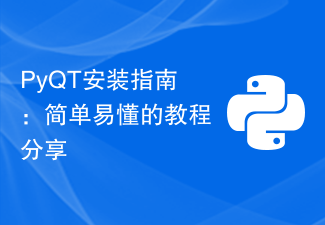 Backend Development
Backend Development Python Tutorial
Python Tutorial Master these flow control statements to ensure that your Python program executes smoothly!
Master these flow control statements to ensure that your Python program executes smoothly!
Want to write Python programs smoothly? Master these flow control statements first!
Python is a simple and elegant programming language that is widely used in various fields, from web development to data science. In the process of writing Python programs, flow control statements play a vital role in helping the program execute according to our expectations.
This article will introduce you to the most commonly used flow control statements in Python, and provide specific code examples to help readers better understand and use these statements.
1. Conditional statement (if-else statement)
Conditional statement executes different code blocks based on the true or false condition. The following is the basic syntax structure of the conditional statement:
if condition:
# 如果条件为真,则执行此代码块
else:
# 如果条件为假,则执行此代码块Example 1: Determine the grade based on the grades entered by the user
score = float(input("请输入你的成绩: "))
if score >= 90:
print("A")
elif score >= 80:
print("B")
elif score >= 70:
print("C")
elif score >= 60:
print("D")
else:
print("E")In the above example, the corresponding grades are printed out based on different grade ranges.
2. Loop statements (for loops and while loops)
Loop statements can repeatedly execute a piece of code, and can be used to traverse a sequence, perform a fixed number of operations, etc. Python provides two commonly used loop statements: for loop and while loop.
- for loop
The for loop is used to traverse an iterable object (such as a list, string, etc.), take out the elements one by one, and execute a piece of code. The following is the basic syntax structure of a for loop:
for item in iterable:
# 对item执行某些操作Example 2: Calculate the sum of integers between 1 and 10
sum = 0
for i in range(1, 11):
sum += i
print("1到10之间的整数之和为:", sum)In the above example, a for loop is used to traverse range(1, 11 ), add each element of the integer sequence to the sum variable, and finally output the result.
- while loop
The while loop is used to repeatedly execute a piece of code when a condition is met. The following is the basic syntax structure of the while loop:
while condition:
# 在条件满足时执行此代码块Example 3: Using the while loop to calculate the Fibonacci sequence
a, b = 0, 1
while b < 1000:
print(b, end=' ')
a, b = b, a + bIn the above example, the while loop is used to generate the Fibonacci sequence, Until the elements in the array are greater than 1000.
3. Break out of the loop (break and continue statements)
Sometimes, we want to jump out of a specific condition in the loop or skip a certain loop directly. Python provides two keywords to achieve this function: break and continue.
- break statement: When a certain condition is met, terminate the current loop.
Example 4: Find an element in the list
fruits = ['apple', 'banana', 'orange', 'grape', 'mango']
for fruit in fruits:
if fruit == 'orange':
print("找到了橙子!")
break
else:
print("没有找到橙子!")In the above example, if the orange is found during the loop using the break statement, the loop will be terminated and the corresponding output will be result.
- continue statement: When a certain condition is met, skip the remaining code of the current loop and directly enter the next loop.
Example 5: Print odd numbers between 1 and 10
for i in range(1, 11):
if i % 2 == 0:
continue
print(i, end=' ')In the above example, use the continue statement to exclude even numbers and only print out odd numbers between 1 and 10.
Summary:
Mastering flow control statements is the basis for writing Python programs. When writing programs, we often need to perform different operations based on different conditions, or repeatedly execute a piece of code multiple times. Through conditional statements and loop statements, we can achieve these requirements well, and use break and continue statements to control the loop process more flexibly.
I hope that through the introduction and sample code of this article, readers can better understand and master the usage of flow control statements in Python, and use them flexibly in the actual process of writing programs to write efficient and elegant Python programs. .
The above is the detailed content of Master these flow control statements to ensure that your Python program executes smoothly!. For more information, please follow other related articles on the PHP Chinese website!
 python常见的流程控制结构有哪几种Dec 12, 2023 pm 04:31 PM
python常见的流程控制结构有哪几种Dec 12, 2023 pm 04:31 PMpython常见的流程控制结构有三种,分别是顺序结构、选择结构和循环结构等。详细介绍:1、顺序结构,这是程序中最简单的结构,按照代码的先后顺序,从上到下依次执行;2、选择结构,这种结构可以根据一定的条件判断,选择执行不同的代码块,在Python中,通常使用“if-elif-else”语句来实现选择结构;3、循环结构,可以重复执行一段代码,直到满足某个条件时停止等等。
 如何通过编写实用代码来掌握 PHP8 扩展的使用Sep 12, 2023 pm 02:39 PM
如何通过编写实用代码来掌握 PHP8 扩展的使用Sep 12, 2023 pm 02:39 PM如何通过编写实用代码来掌握PHP8扩展的使用引言:PHP(HypertextPreprocessor)是一种广泛使用的开源脚本语言,常用于编写Web应用程序。随着PHP8的发布,新的扩展和功能使得开发者能够更好地满足业务需求和提高代码效率。本文将介绍如何通过编写实用代码来掌握PHP8扩展的使用。一、了解PHP8扩展PHP8引入了许多新的扩展,如FFI、
 golang流程控制语句有哪些Dec 28, 2022 pm 05:58 PM
golang流程控制语句有哪些Dec 28, 2022 pm 05:58 PM流程控制语句:1、if语句,由一个布尔表达式后紧跟一个或多个语句组成;2、“if…else”语句,else中的表达式在布尔表达式为false时执行;3、switch语句,用于基于不同条件执行不同动作;4、select语句;5、for循环语句,语法“for k,v := range oldmap{newmap[k]=v}”;6、循环控制语句break、continue、goto。
 Python中常见的流程控制结构有哪些?Jan 20, 2024 am 10:38 AM
Python中常见的流程控制结构有哪些?Jan 20, 2024 am 10:38 AMPython中有四种常见的流程控制结构,分别是顺序结构、条件结构、循环结构和跳转结构。下面将一一介绍并提供相应的代码示例。顺序结构:顺序结构是程序从上到下按照预定的顺序执行的结构,没有特定的关键字或语法。示例代码:print("这是顺序结构示例1")print("这是顺序结构示例2")print("这是顺
 重要的Spring学习内容:了解常用注解的使用指南Dec 30, 2023 pm 02:38 PM
重要的Spring学习内容:了解常用注解的使用指南Dec 30, 2023 pm 02:38 PM学习Spring必备:掌握常用注解的使用方法,需要具体代码示例引言:Spring框架是目前广泛应用于Java企业级应用开发的开源框架之一。在Spring的学习过程中,掌握常用注解的使用方法是非常重要的。本文将介绍几个在Spring开发中常用的注解,并结合代码示例详细说明它们的作用和用法。一、@Component@Component是Spring框架中最
 PyQT安装指南:简单易懂的教程分享Feb 19, 2024 am 08:21 AM
PyQT安装指南:简单易懂的教程分享Feb 19, 2024 am 08:21 AM轻松掌握PyQT安装技巧:详细教程分享PyQT是一种流行的PythonGUI库,它提供了丰富的功能和工具,帮助开发者快速而轻松地创建用户界面。PyQT的安装过程可能对于初学者来说有些困惑,本文将详细介绍PyQT的安装方法,并附带具体的代码示例,以帮助读者轻松掌握这一技巧。安装Python和PIP在开始安装PyQT之前,首先需要确保电脑上已经安装了Pytho
 必学!深入解析Python中常用的流程控制语句Jan 20, 2024 am 09:37 AM
必学!深入解析Python中常用的流程控制语句Jan 20, 2024 am 09:37 AM小白必看!Python中常用的流程控制语句解析,需要具体代码示例导语:Python作为一门简洁而强大的编程语言,具有简单易学的特点,适合初学者入门。而流程控制语句是编程中的核心,通过掌握流程控制语句,可以让你的程序编写更加灵活和高效。本文将为你详细解析Python中常用的流程控制语句,并配以具体的代码示例,希望对你的学习有所帮助。一、if语句if语句是Pyt
 了解Python中的流程控制语句需要掌握几种情况Jan 20, 2024 am 08:06 AM
了解Python中的流程控制语句需要掌握几种情况Jan 20, 2024 am 08:06 AMPython是一种广泛使用的高级编程语言,它具有简单易学、高效灵活的特点,深受开发者的喜爱。在Python中,流程控制语句是实现程序逻辑的重要部分。本文将介绍Python中常用的流程控制语句,并提供代码示例加深理解。在Python中,常见的流程控制语句包括条件语句和循环语句。条件语句根据条件的真假执行不同的代码块,用于判断和选择执行分支。而循环语句则用于重复


Hot AI Tools

Undresser.AI Undress
AI-powered app for creating realistic nude photos

AI Clothes Remover
Online AI tool for removing clothes from photos.

Undress AI Tool
Undress images for free

Clothoff.io
AI clothes remover

AI Hentai Generator
Generate AI Hentai for free.

Hot Article

Hot Tools

MantisBT
Mantis is an easy-to-deploy web-based defect tracking tool designed to aid in product defect tracking. It requires PHP, MySQL and a web server. Check out our demo and hosting services.

Atom editor mac version download
The most popular open source editor

Dreamweaver Mac version
Visual web development tools

Notepad++7.3.1
Easy-to-use and free code editor

SublimeText3 English version
Recommended: Win version, supports code prompts!





